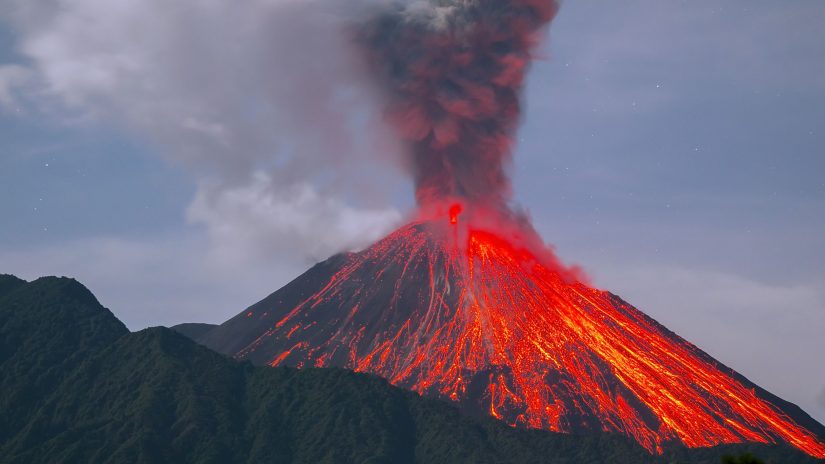Due to its geographical location, the Hawaiian Islands are truly unique and inimitable. As the only US state entirely on volcanic rock, Hawaii is replete with spectacular volcanoes over 70 million years old. It could even be argued that all of Hawaii is just a chain of huge volcanoes with a base deep in the ocean. And what can be seen above the water is only a small part of them. Each island in Hawaii is living proof that the volcanoes that formed them erupted many times until the moment when their top was above sea level. Although there are many underwater volcanoes near Hawaii, in this section we will try to describe in detail only those that formed the Hawaiian Islands chain.
/GettyImages-608873707-f359835d93ea4f0b95a50cbeeb839c05.jpg)
Volcanoes of the Big Island:
Mauna loa
Mount Mauna Loa, 96 km long and 48 km wide, covers an impressive 85% of the islands’ total land area. Translated from Hawaiian Mauna Loa means “long mountain” – a volcano, whose 4,117 m above the ocean surface. Being one of the highest mountains in the world, Mauna Loa is also the most active volcano in the world. Snow forms at the top of the volcano in winter.
The first eruption of the volcano occurred in 1843, followed by 33 more. The last eruption of Mauna Loa took place in March-April 1984. Scientists are constantly monitoring the activity of the volcano, as eruptions are expected in the near future.
Mauna Loa is a shield volcano: this means that the volcano slowly “grew” due to lava layers. Interestingly, these types of volcanoes form even on other planets. For example, it was in this way that the largest mountain in the entire solar system was formed – the Olympus volcano on Mars.
Kohala
This volcano is more than 500,000 years old and is the oldest land volcano. Kohala is a shield volcano with a height of 1,670 m, occupying 5.8% of the island’s surface. Scientists have calculated that the volcano’s activity began to fade 300,000 years ago, when the volcano was twice as wide as it is now. Kohala is currently completely inactive. As researchers suggest, its last eruption occurred 120,000 years ago.
While the Kohala volcano gradually faded, the eruptions of the younger and more active volcanoes Mauna Kea and Mauna Loa altered its southern slope. It is for this reason that it is very difficult to determine the exact shape of the mountain and its size at that time.
Loihi
Loihi Volcano, the youngest volcano in the Hawaii volcanic chain, is 1,000 m below the water level and is an underwater volcano. Loikhi, 3000 m high, is located off the southeastern coast of the Big Island. The name “Loihi” can be translated as “long”.
Not far from Loiha are Mauna Loa and Kilauea. This volcano was once dormant, but it awakened with a prolonged eruption in 1996. Since this year, the volcano erupts from time to time.
Kilauea
Kilauea volcano is quite young, but this does not prevent it from being one of the most active volcanoes on Earth. Kilauea is located in the southeastern part of the Big Island, on the slope of the active Mauna Loa volcano. The volcano is constantly under scientific observation.
The name Kilauea means “eruption” or “expansion”, which reflects its nature: the volcano has been constantly erupting since 1983. Kilauea Volcano holds a special place in Hawaiian mythology. Many residents believe that the volcano is the home of Pele, the goddess of fire and volcanoes. If she is given offerings and encouraged in every way, she can be calm and merciful, but if angry she can cause an eruption.
Mauna Kea
The shield volcano Mauna Kea rises 4,205 m above the surface of the water, and more than 6,000 m below sea level: a total height of more than 10 km makes this volcano the highest mountain on Earth. Translated from the Hawaiian language, “Mauna Kea” means “white mountain”, and this volcano is significantly different from its neighbors – the volcanoes Mauna Loa and Kilauea. Currently, Mauna Kea is considered dormant, since its last eruption occurred more than 4,500 years ago. Minor eruptions occur periodically, but since the main crater has not survived, the chemical composition of the lava is always different. Mauna Kea is a unique volcano, as glaciers formed on it thousands of years ago. Few people would think that Hawaii might have a glacier! In winter, the top of the volcano is covered with a snow cap.
Mahukona
Mahukona is an underwater volcano located off the northwestern coast of the Big Island. It was once 243 m above sea level, but now it is 1,100 m lower. Translated from Hawaiian it means “steam coming from the leeward side of the island.”
Hualalai
The volcano is the third youngest and third most active volcano on the Big Island (after the volcanoes Mauna Loa and Kilauea). The city of Kailua-Kona, the birthplace of the famous coffee Kona, is erected on the southwestern slope of the Hualalai volcano. The volcano is named after the wife of the famous Hawaiian seafarer Loa, Hawaii.
